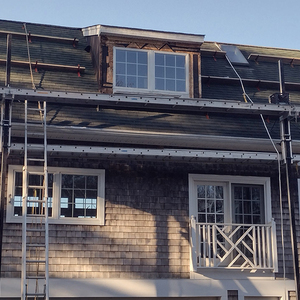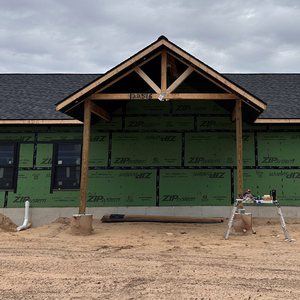Good article on insulation, but…
I want to congratulate you on a great insulation article in the last issue (FHB #160, pp. 50-55), though I’m sure you must be getting some hate mail from the fiberglass industry by now. I think you did a good job overall with one of the most difficult and unintuitive systems that we use in the construction industry (second only to vapor control).
Of course, there are some finer details I could quibble about—most notably, the idea that spraying foam in cavities inherently makes a house tight (remember, there are some types of leaks that don’t happen in the cavities)—but I do have to point out a couple of things.
First, the caption on p. 52 for the photo of encapsulated batts is misleading. The pink wrapping on three sides is not a vapor barrier; it’s there only to keep weekend warriors from getting itchy (and in the process making the batt even more difficult to install correctly). Only the side with the printing is a vapor barrier, and it’s important that this be installed to the warm side.
Second, I disagree with the caption, also on p. 52, that asserts unfaced batts would be used only in places where a poly vapor barrier is needed. I tend to agree with Joe Lstiburek that poly is needed only in extreme cold, but there are other very good uses for unfaced batts, including hot, humid climates, or atypical wall assemblies (like in an R-11 wall with R-10 or more of rigid foam on the exterior in a mixed-to-cold climate).
And finally, EPS is fine for below-grade applications. There was a good article in the August 1999 Energy Design Update that featured research showing that EPS is just as durable below grade in long-term tests as XPS. I still wouldn’t use it under a slab because of the lower compressive strength, but because of the lower cost and much smaller environmental impact (and the option for borate treatments), I’m liking it more and more for most other applications.
—Bruce Harley, Stamford, Vt.
Blown-in fiberglass is highly effective
I was very disappointed by Scott Gibson’s article “Does Fiberglass Still Make Sense?” (FHB #160, pp. 50-55). He was determined to show all the positive points of foam products, and he downplayed the tremendous improvements that have resulted from using fiberglass in the Blow In Blanket System (Ark-Seal; 800-525-8992; www.arkseal.com). We realized years ago that fiberglass batts do not work as well as a product that is custom-made on the job site. That was the reason we took fiberglass loose fill and made a high-density blow-in insulation that fills every cavity perfectly, eliminating gaps that cause air infiltration. More important, the cost of this system to the builder and homeowner is substantially less than foam products. Air-infiltration tests done by the NAHB Research Center show that air leakage in a BIBS wall is reduced by only 7% when you add a housewrap air barrier, proving the flow rates of the BIBS wall were pretty low to begin with.
—Jesse Aragon, President, Blow In Blanket Inc., Denver, Colo.
Scaffold plank is no LVL
In the article “Simple Homemade Scaffolding” (FHB #160, pp. 86-87), you showed a photo of different scaffold planks and identified one as an LVL plank. That was not an LVL plank. It’s a laminated scaffold plank and looks like a LeeLite Scaffold Plank (www.leestructuralwood.com). LeeLite is made in Canada, of Canadian spruce lumber, with glued butt joints on the sides and glued finger joints at the ends. It is a very good product, but it is not an LVL.
—Douglas A. Holman, via email
An argument for metal plates when framing walls in place
Tom O’Brien’s steps and tips for framing in-place walls are classic (FHB #160, “Building Skills,” pp. 120, 122). I regularly use the same methods when installing bearing walls on remodeling projects. But when framing nonbearing partition walls, I mix my materials. I usemetal track rather than wood for the top and bottom plates. The open C-channel design of the track has a few advantages that save time.
Rather than cutting each individual stud to the precise length between wood plates, I save time by gang-cutting the studs up to 1⁄2 in. short of the track webs. After setting the track like Tom suggests, using a plumb bob, I measure the stud lengths every 4 ft. or so to gauge the height deviation between the tracks. I pick a stud length that allows for a 1⁄8-in. space at the shortest height and as much as 1⁄2 in. at the longest. If the plates deviate more than 1⁄2 in., I cut a second batch of studs for the taller run.
Installing studs between the tracks is a joy. The track flanges grip the edges of the studs, holding them upright. I position all the studs on my layout marks, then return to drive fasteners. I save time by not having to insert each stud and fasten it before moving to the next one. Rather than handnailing, I prefer to use a pneumatic nailer to drive in one 6d common nail from either flange, or use a cordless drill or driver to spin in 11⁄4-in. screws. And on the short studs, I split the gaps between the top and bottom tracks so that there’s never more than a strong 1⁄4-in. gap. I walk the length of the wall fastening the tops first, then fasten the bottoms on my return trip.
To a wood purist, this may sound like hack carpentry, but these hybrid wall assemblies are as strong as their wood-plated counterpart, maybe more so.
—Mike Guertin, East Greenwich, R.I.
Code requires shingle underlayment to run parallel with the eaves
In Fine Homebuilding #158, your “Breaktime” column included a post about running felt paper vertically up the roof (i.e., perpendicular to the eaves). The International Residential Code of 2000 states in section R905.2.7 that “underlayment shall be shingle fashion, parallel to and starting from the eave and lapped 2 in., fastened sufficiently to hold in place. End laps shall be offset by 6 feet.”
Two of the three respondents gave inaccurate and/or misleading answers. You should have suspected that this situation would be a code issue, researched the answer yourselves, and answered accordingly.
—Steve Bibby, San Marcos, Texas
Changing bits without busting knuckles
In the last issue, the article on routers (FHB #160, pp. 70-75) contained a photo of an individual attempting to use two wrenches to change bits. The caption was accurate. If you were to use the tools in that fashion, your knuckles would most likely take a hit; also, holding wrenches that way leaves you unable to apply leverage well.
I have found that placing the wrenches on each nut in such a way as to be able to squeeze them together (as you would the handles of pliers) is simpler and safer, and you tend not to overtighten. Both tightening and loosening of the nuts can be accomplished in this manner.
—Robert E. Rockwell, via email
Nobody needs a $10,000 sink
Aren’t you guys ever revolted by the incredible waste represented by a $10,000 kitchen sink (FHB #159, “Kitchen Sinks that Shine,” pp. 46-53)? When Bucky Fuller said “do more with less,” he meant that the less I consume, the more resource there is left for everyone else in the world. When a $10,000 sink functions no better than a $200 sink, it is literally $9,800 of world resource down the drain. “Fine” homebuilders should be educating their wealthy clients rather than condoning conspicuous consumption.
—Alan Amenta, Glenmoore, Penn.
Opinions differ on 10 rules for framing
As an avid reader of your magazine, and a damn good carpenter, I was baffled by Larry Haun’s article “10 Rules for Framing” (FHB #158, pp. 74-79). One-quarter in. out of plumb on 8 ft.? Acceptable? Perhaps you should consider changing the name of your magazine to “Pretty Good Homebuilding.”
—Hal Ketchum, Nashville, Tenn.
The article “10 Rules for Framing” in the October/ November issue was a real jewel. This article alone is well worth the cost of a yearly subscription. Keep up the good work, and thanks to Larry Haun for submitting this informative and timely article. I will be keeping all his suggestions in mind.
—Jerry Walter, Troy, Ohio
Agrees owners should forget resale value
Finally, someone spoke up about resale value (“Forget about resale value,” FHB #159, pp. 8, 10, 12). I am a residential designer, and it eats me up when a client for a custom home brings up resale value. I have to take three deep breaths before I respond. It’s too bad so many people design for the next guy in line.
Do it right, and do it for yourself. The value is in living in a home that is tailored to all your needs. We are all individuals and should live in homes that speak to that, not to the next guy’s Realtor. Thanks to author James Krengel for speaking out. Now I have something to back up my ranting.
—Derek Hurd, Boise, Idaho
Why no waterproofing behind cementboard?
Tom Meehan certainly created a beautiful shower in his article “Upgrading to a Tile Shower” (FHB #160, pp. 88-93), but I see that he has no waterproofing behind the cement backerboard on the walls. Here in California, the inspector must sign off on the moisture barrier in tiled shower areas. This barrier usually consists of nothing more than #15 saturated felt applied horizontally and neatly folded in the corners.
I don’t think it would break the bank to spend 15 minutes and $15 to provide an ounce of prevention for this $5,000 shower. Let’s keep the “fine” in Fine Homebuilding.
—Kurt Housh, San Anselmo, Calif.
Author Tom Meehan replies: Years ago, I used a membrane behind the backerboard. The problem was that when I ripped out showers on remodeling jobs, I often found mold and bacteria trapped between the moisture barrier and the substrate. My feeling now is that on an average job that has tile or stone properly installed with thinset cement over cementboard and has a good sealer applied, there is no need for a membrane behind the cementboard. I do like to put a 4-in. strip of membrane wrapped into each of the corners that drapes back into the pan. This strip protects the installation if any of the walls settle as the lumber dries.
In the cases where I think a membrane is needed (such as a steam shower), there are very good membrane systems that are applied to the surface of the cementboard and then tiled over. This way moisture never enters the backerboard at all. Many companies make these products, including The Noble Co. (www.noblecompany.com; 800-878-5788) and Laticrete International (800-243-4788; www.laticrete.com).
Thinks back-cover staircase was wasteful
I was appalled at the back cover of your October/November issue (FHB #158). If people want to spend $50,000 for a staircase, that’s their business. But for you to glorify the use (read waste) of 4000 board ft. of prime timber to make a post is revolting.
—Steve Denker, Cornucopia, Wis.
Steel-deck construction requires an engineer
In John La Torre Jr.’s response to Jon Montelin’s question on concrete porch-floor construction (FHB #160, “Q&A,” p. 106), the only sound advice was to consult an engineer. The design of elevated concrete slabs cannot be done by simply referring to a deck manufacturer’s catalog. The response made no mention of the differences between composite and noncomposite decking, the magnitude of the superimposed live and dead loads, the function of the reinforcing steel, or whether this assembly is even suitable for an exterior exposure. In addition, the Steel Deck Institute (which publishes the design standards and specifications for steel-form decking and roof decking) would not condone the use of a spray-applied rubber membrane between the deck and concrete, as it would act as a bond-breaker. Fine Homebuilding should refer questions that involve the practice of engineering to engineers.
—Paul Smith, Hanover, Mass.
Projects wanted for Taunton book
Architect Ross Chapin is at work on a new book for The Taunton Press and is looking for houses, new or remodeled, that he describes as “alive and vibrant.” According to Chapin, “The homes I want may be profound and stunning, but are just as likely to be simple and unassuming. I am not looking for a particular style, but color, light, ornament, and detail are likely to be features.”
Please send photos, a floor plan, and a written description that includes date of completion and square footage to Ross Chapin Architects, 195 Second St., P. O. Box 230, Langley, WA 98260. Photos do not have to be professional; digital photos or snapshots are fine. For more details, go to www.rosschapin.com.
Errata
In the article “Pressure-Treated Wood: the Next Generation” (FHB #160, pp. 82-85), we reported that the new preservatives are “five times more corrosive to common steel, according to American Wood Preservers Association (AWPA) test results.” We should have said “ … according to results of tests conducted by Chemical Specialties Inc., in accordance with AWPA test standards.”
Also, our apologies to Gordon Kadar, whose work we featured on p. 99 of our Kitchens & Baths issue (FHB #159). In the photo caption, we mistakenly listed his name as George.
Fine Homebuilding Recommended Products
Fine Homebuilding receives a commission for items purchased through links on this site, including Amazon Associates and other affiliate advertising programs.

Affordable IR Camera

Reliable Crimp Connectors

Handy Heat Gun






















